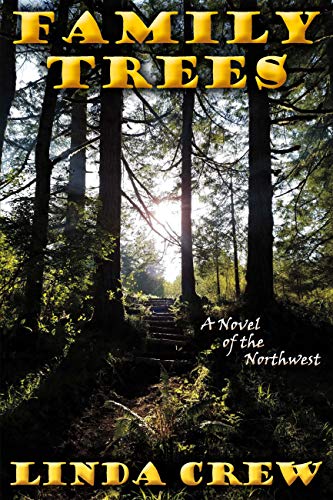
Family Trees: A Novel of the Northwest by Linda Crew is a multi-layered story of a large family-owned timberland company near Corvallis, Oregon. The story mostly takes place in 2009, but occasionally toggles back to different time periods.
The two main characters, Will Trask and Bridget Garland have known one another for years. Will’s deceased wife was a Garland, owners of the timber company. Will, the son of a logger, is a well-respected forestry consultant and real estate agent. He straddles two worlds: those who own the forests and those who cut them down. Will has two sons, one just starting college and the other, sixteen, still at home.
Bridget Garland, sick of her husband John’s infidelities, is ending their almost twenty-year marriage. She never has felt like one of the Garland family. Bridget is a popular physical therapist, not an occupation the Garland’s embrace. Bridget and John have one daughter who is just starting college.
The community looks to the Garlands for many leadership roles, college grants and other philanthropic endeavors. Will has always played a reluctant part in this aspect of the family business. Now that Bridget is divorcing John, she won’t be a participant either. Will and Bridget are drawn together with many common interests. Bridget has always admired Will, his strength and integrity. Will finds that he enjoys being with Bridget—she’s fun and lively. They share many common interests—but he can’t seem to let go of his wife’s memory and the guilt associated with her death.
When a surprising incident occurs, it becomes a true test of character. Will those involved be able to cope and move on?
I thoroughly enjoyed Family Trees. I appreciated learning about large family-owned businesses, their community responsibilities, and their struggles to get along with one another. I also enjoyed Will and Bridget’s individual family dynamics, particularly as the young college-age children perceived their parents in a different light, often not favorably. I also enjoyed venturing into Oregon’s forested wilderness, and learning what it takes to keep this valuable resource sustainable.


Thank you, Mary, for introducing us to this novel. There are two sides of this issues. And it is complicated. I’ll add this book to my “to Read List.”
I agree, Hema. I think this novel brings out both sides of this issue. Timber can be a touchy issue. It is a renewable resource, but it has to be handled with care.
Nice to see this review by Linda Crew. We were in the same writers’ group in the past, Haven’t seen her for years. The book sounds good,
I really enjoyed it. While reading it I often thought of Weyerhaeuser and how it must be for those associated families. Thanks for your comment, Irene.